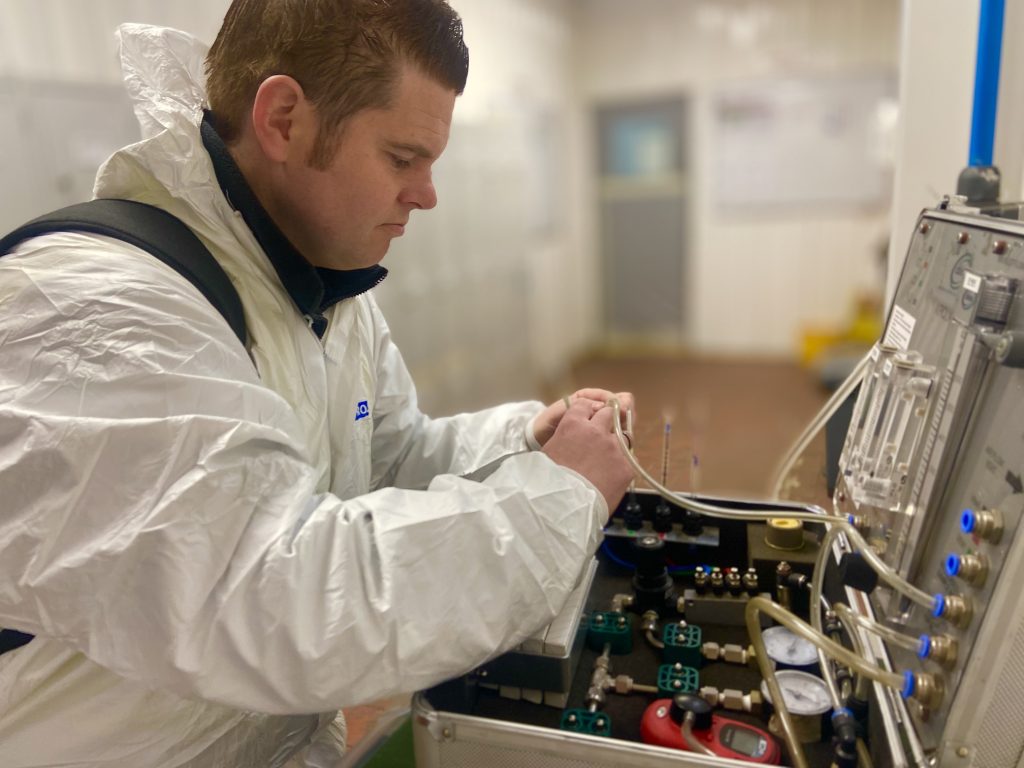UK Wide
We provide sampling and consultancy services throughout the UK and Ireland
Affordable
We are happy to provide you with an obligation free estimate for work
How it works
About this service
Breathing Air Quality Testing: Ensuring Respiratory Safety and Health in Compressed Breathing Air Supplies
Clean and safe breathing air is vital for maintaining human health and well-being, especially in environments where air quality might be compromised. Breathing air quality testing is a critical process that involves analyzing the quality of air to ensure it meets specific standards for respiratory safety. This practice is particularly crucial in confined spaces, industrial settings, and any situation where individuals are at risk of inhaling contaminants that can lead to respiratory issues or other health problems.

The importance of Breathing Air Testing:
Breathing is a fundamental human need, and the air we breathe should ideally be free from harmful contaminants. In various industries and work environments, workers might be exposed to environments with airborne pollutants, toxic gases, dust, or low oxygen levels. Breathing air testing ensures that the air provided for respiratory protection, such as in self-contained breathing apparatus (SCBA) or supplied air systems, meets the required quality standards. This not only safeguards workers but also ensures compliance with occupational health and safety regulations.
Why is Breathing Air Quality Testing Necessary?
Breathing air testing to BS EN 12021:2014, also known as compressed air quality testing is necessary to ensure that the air supplied to a worker’s air-fed helmet is of good quality. By suitable quality, we mean that it does not contain any contaminants at levels that can harm the user
Which contaminants does BS EN 12021:2014 specify for Compressed Breathing Air Quality Testing?
BS EN 12021:2014 specifies the following contaminants. These are:
Oxygen Content: The oxygen concentration in breathing air needs to be within a safe range (typically around 20.9%) to prevent hypoxia (low oxygen levels) or hyperoxia (high oxygen levels) that can lead to health risks.
Contaminants: Testing checks for the presence of carbon monoxide (CO), and carbon dioxide (CO2).
Oil Mist: Many compressed air systems use lubricated compressors, where oil is used to lubricate moving parts and maintain their operation. A small amount of oil can carry over from the lubrication process into the compressed air stream, leading to oil mist contamination.
Humidity: Excessive humidity levels can lead to moisture-related issues within respiratory equipment and affect air quality. Proper humidity levels are necessary to prevent mold growth and other problems.
Pressure: Breathing air systems might be pressurized to ensure a steady flow of air to the user. Monitoring and maintaining appropriate pressure levels are essential for respiratory equipment to function effectively.
Microbial Contamination: In certain environments, microbial contamination can occur, potentially leading to respiratory infections. Testing can identify the presence of harmful microorganisms.
How do the contaminants get into the air?
Breathing air testing specifies several hazards. These enter the air in the following way:
The air intake of a compressor may draw in carbon dioxide and carbon monoxide from an outside source. Carbon dioxide is an asphyxiant, and carbon monoxide is toxic because of the way it reacts with the breather’s blood.
A failing air compressor pump or failing filtration can cause the oil in the air-line. This oil gives rise to toxic volatile substances in the air.
The compressed air quality testing measures the amount of oxygen in the air because a dryer malfunction can reduce the oxygen to an unsafe level.
Water and dew point measurements are essential to prevent the condensation or freezing of water in the air-line. This freezing could disrupt the supply of air to the user.
Changes in the compressor and filter performance can happen rapidly. For this reason, the HSE requires that the test is at least every three months. For rarely used equipment, they require compressed air quality testing before each use. Employers must store the records of these tests and repairs for a period of at least five years.
BS EN 12021:2014 Limits
The purpose of the test is to make sure that the control measures put in place by the employer, such as inline filters, are delivering the air quality required by BS EN 12021:2014. In summary, BS EN 12021:2014 sets these limits for breathing air testing:
- Oxygen must be at 21% ± 1%.
- Carbon monoxide must be as low as possible and must not exceed 5 ppm.
- Carbon dioxide must not exceed 500 ppm.
- Oil mist and vapour must not exceed 0.5 mgm-3
- Odour/taste – Without significant odour or taste.
- Water (liquid) – 290 mgm-3 at 5 bar and 20oC.
Also, the compressed air must show a dew point low enough to prevent condensation and freezing. In particular, the dew point of the air must be at least 5oC below the lowest temperature that the operators use and store the equipment. Furthermore, the pressure dew point must not exceed -11oC where the conditions of usage and storage are unknown.
Companies should base the frequency of breathing air testing on a risk assessment. However, it should take place at least every three months. The test should be more often when a company cannot assure that they meet these levels.
Further Information on compressed air quality testing is available below

Available COSHH services
We’re happy to answer any questions you have, or provide you with an obligation free estimate for work. Just send us a message!
01782 614236 or [email protected]
Get in touch
Contact
Synergy Environmental Solutions provide
sampling and consultancy services
throughout the UK and Ireland
We’re happy to discuss any questions you have,
or provide you with an obligation
free estimate for work.
Just send us a message!
Email: [email protected]
Tel: 01782 614236



